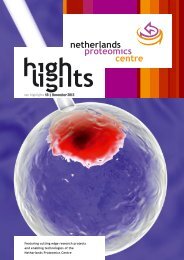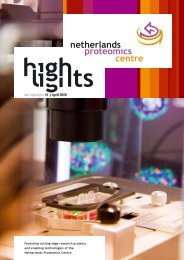NPC Progress Meeting 2012 - Netherlands Proteomics Centre
NPC Progress Meeting 2012 - Netherlands Proteomics Centre
NPC Progress Meeting 2012 - Netherlands Proteomics Centre
- No tags were found...
You also want an ePaper? Increase the reach of your titles
YUMPU automatically turns print PDFs into web optimized ePapers that Google loves.
What this research is about:Search for new medicines based oninhibition of the enzyme autotaxinAutotaxin (ATX) is an important enzyme for the hydrolysisof the lipid lysophosphatidylcholine (LPC) into lysophosphatidicacid (LPA) and choline. The bioactive lipid LPA is ableto activate several cellular processes like growth, migrationand survival. ATX and LPA have been implicated in variousdiseases including cancer, inflammation and fibrosis. “Inorder to study the exact role of ATX and LPA in these diseaseswe have been looking for ATX inhibitors,” says HaraldAlbers, who just finished his PhD research on this topic atthe <strong>Netherlands</strong> Cancer Institute (NKI-ALV). “By blockingthe activity of ATX, one can study the effect of ATX on thedevelopment of disease. If one obtains a positive effect, theinhibitors can be used as a starting point for the developmentof future medicines.”Albers and colleagues started this research by screeninga large library of 40,000 drug-like small molecules. Albersmade many chemical modifications on the most promising inhibitorresulting from this screening to improve its potency.The introduction of a specific chemical group, a boronicacid, into the compound improved the affinity for ATX tremendously.In mice this boronic acid-based inhibitor inducesa remarkable and instantaneous decline in LPA levels in theblood, showing that this inhibitor can target ATX in vivo.“After some time our Structural Biology colleagues at the NKIwere able to obtain a crystal structure of ATX bound to ourinhibitor. This was an important step forward since it allowedus to study the binding of the inhibitor with ATX in more detail.It furthermore enabled us to develop novel inhibitors in arational manner.” In the meantime pharmaceutical companieshave become very interested in ATX inhibitors. Pfizer andMerck have set up their own ATX inhibitor programmes. Albersis now working on the latest ATX inhibitors and will continuehis research as a postdoc at the NKI-AVL.| <strong>NPC</strong> T1: Cancer <strong>Proteomics</strong>ATXHONCholineFigure 1 | LPA-mediated bioactivity. The enzyme autotaxin (ATX) is responsiblefor the hydrolysis of lysophosphatidylcholine (LPC) into lysophosphatidicacid (LPA) and choline. LPA activates specific G protein-coupled receptorsstimulating migration, proliferation and survival of cells.showed an IC 50 value of 2.5 μM in the LPC hydrolysis assayused for in vitro inhibitor validation.On OOHLPCExtracellularOOPOONMigrationnOOOHLPAGOProliferationOPOOSurvivalTargeting the active site We next sought to target thethreonine oxygen nucleophile in the ATX active site. Wereplaced the carboxylic acid in inhibitor A with a boronicacid. Our rationale was that the carboxylic acid moiety ofinhibitor A could function as a phosphate mimic and therebybind near or at the threonine oxygen nucleophile, in whichcase the threonine oxygen nucleophile in ATX could be targetedvia a boronic acid.Boronic acid has previously been shown to be instrumental inthe anticancer drug bortezomib, which targets the threonineoxygen nucleophile in the active site of the proteasome.Replacing the carboxylic acid in inhibitor A with a boronicacid yielded compound HA130 (see Figure 2) with a ∼100-fold






